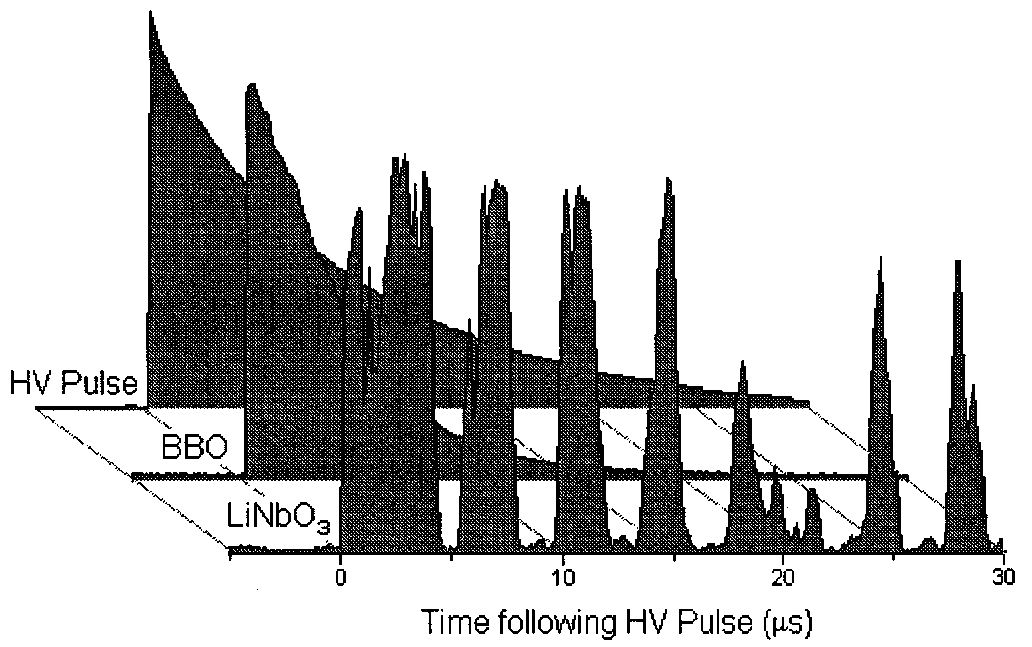$380.00
Specifications:
| Materials | Beta BBO crystals | Size Tolerance | (3±0.1mm)x(3±0.1mm)x(20+0.5/-0.1mm) |
| Cut Angle | Z-Cut | Clear Aperture | central 90% or the diameter |
| Scattering of Crystals | No visible scattering paths or centers when inspected by a 50mW green Laser |
Flatness | less than λ/8 @ 633nm |
| Transmitting Wavefront Distortion | less than λ/8 @ 633nm | Chamfer | ≤0.2mmx45° |
| Chip | ≤0.1mm | Surface Quality | better than 10/5 S/D (MIL-PRF-13830B) |
| Parallelism | ≤20 arc seconds | Perpendicularity | ≤5 arc minutes |
| Angle Tolerance | ≤0.25° | Coating | AR/AR@1064nm on both end surfaces Cr-Au electrode on two side surfaces |
| Quarter-wave voltage@1064nm | ~3.4kV | Optical Transmission | >98% |
| Typical capacitance | 3pf | Damage Threshold | >500MW/cm^2 @1064nm, 10nS |
| Quality Warranty Period | one year under proper use |
Features:
BBO crystals exhibit significant advantages over other materials in terms of laser power handling abilities, temperature stability, and substantial freedom from piezoelectric ringing. Because it relies on the electro-optical effect, switching time - aided by the low capacitance of the Electro-Optical Q Switch is very fast, therefore it is an splendid choice for high repetition rate lasers up to 1MHz , and all-solid-state short-cavity Q-switched laser using BBO electro-optic Q-switch can generate high-energy laser with a pulse width of less than 4ns, which is the preferred light source for electro-optic internal engraving machines. Without water cooling, the BBO electro-optical Q switch can be turned off and withstand up to 150W intracavity oscillation optical power (laser output power up to 50W). In addition BBO crystals has a wide transparency range of 200nm to 1650nm, which allows it to be used in diverse applications from UV to NIR spectrum.
Hangzhou Shalom EO offers BBO crystals used in the pockels cells with high precision polishing, AR coating and Cr-Au electrodes, stocked crystals of standard specifications is ready for selecting, and the customized special crystals is also available upon customer's request. Besides we also offer BBO crystals for nonlinear applications.
Features of BBO crystal:

Fig.1 Qualitative comparison of acoustic ringing in BBO and LiNbO3
The intensity transmitted through the LiNbO3 Pockels cell varies greatly due to piezoelectric effects, whereas the light transmitted through the BBO Pockels cell
follows the decay of the applied high voltage pulse with no evident acoustic ringing
Applications:
Application Notes:
Calculation of Quarter-wave Voltage
The voltage required to produce a retardance of π radians is called the halfwave voltage or simply Vπ. For an optical input linearly polarized 45o applying a halfwave voltage rotates the polarization by 90o. When the output wave is passed through a linear the resultant can be rapidly modulated from maximum intensity to minimum intensity by rapidly changing the voltage applied to the crystal from 0 volts to Vπ.
The halfwave voltage of BBO is dependent on the optical wavelength and is given by:

Where λ=optical wavelength
d=electrode spacing
L=optical path length
r22=electro-optic coefficients
no=ordinary indices of refraction

EO Q-Switch 1/4Wave Voltage Vs wavelength (3x3x20mm)
1/4 Wave Voltage @1030nm : Vπ/2 =3388V